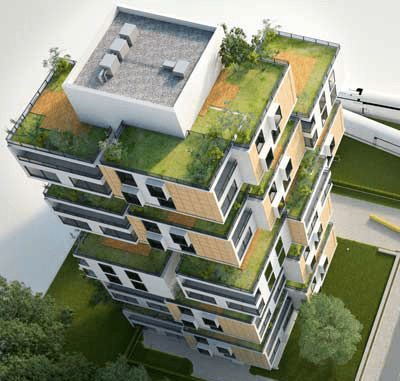Sarah Khan
Centre for Study of Science, Technology and Policy (CSTEP), Bengaluru, India
Corresponding Author: sarah.khan@cstep.in
Sweta Bhushan
Centre for Study of Science, Technology and Policy (CSTEP), Bengaluru, India
Cite this article
Highlights
- Strategic pathways for sustainable development in India’s residential sector.
- Study focuses on reducing carbon impact, which is crucial for achieving the net-zero target.
- Practical implications for energy-efficient interventions, aiding informed decision-making.
- Sectoral connections and resource considerations emphasized for effective net-zero transition.
- Incorporating thermal comfort enhances the potential for significant operational energy savings.
Abstract
This study analyzed potential low-carbon pathways to achieve net-zero residential buildings in India. With the building sector contributing to 33% of global energy-related CO2 emissions, decarbonizing it is crucial for a net-zero economy. The study used a system dynamics model—Sustainable Alternative Future for India—to capture sectoral interlinkages and explore the implications of meeting India’s development goals related to energy, resources, materials, and emissions. Three scenarios were developed, constituting interventions from the building, power, and material industry sectors. The business-as-usual scenario assumes that existing policies will persist, whereas the other two decarbonization scenarios consider different levels of realistic interventions, such as electrification and behavioural shifts. The study discusses the residential cooling demand and transition cost to high-efficiency appliances. Furthermore, it highlights the importance of considering sectoral interlinkages and resource constraints in achieving net-zero energy residential buildings.
Keywords
Residential Sector, Greenhouse Gas Emissions, System Dynamics, Operational Energy, Embodied Energy
References
- S. S. H. Pallerlamudi, “Reducing embodied carbon is key to meeting India’s climate targets,” RMI India, November 12, 2021. https://rmi-india.org/reducing-embodied-carbon-is-key-to-meeting-indias-climatetargets/
- Bureau of Energy Efficiency, Ministry of Power, Government of India, “Energy efficiency in buildings,” https://saathee.beeindia.gov.in/Common/BEEContent?MID=2&SMID=44
- R. Dalal, K. Bansal, and S. Thapar, “Bridging the energy gap of India’s residential buildings by using rooftop solar PV systems for higher energy stars,” Clean Energy, 5 (3), pp. 423-432, 2021. https://doi.org/10.1093/ce/zkab017
- Rocky Mountain Institute and National Institute of Urban Affairs, “From the Ground Up,” November 2022.
- Government of India, “Houses for all under Pradhan Mantri Awas Yojana-Gramin,” https://pib.gov.in/pib.gov.in/Pressreleaseshare.aspx?PRID=1883183
- Ozone Cell, MoEFCC, “India cooling action plan,” 2019. [Online]. Available: http://ozonecell.nic.in/wpcontent/uploads/2019/03/INDIA-COOLING-ACTION-PLAN-e-circulation-version080319.pdf
- CSTEP, “Energy and emissions implications for a desired quality of life in India, via SAFARI,” 2020. [Online]. Available: https://www.cstep.in/drupal/sites/default/files/2020-06/CSTEP_RR_SAFARI_2020.pdf
- S. Chatterjee, B. Kiss, D. Ürge-Vorsatz, and S. Teske, “Decarbonisation pathways for buildings,” pp. 161-185, 2022. https://doi.org/10.1007/978-3-030-99177-7_7.
- Ministry of Housing and Urban Affairs, “PMAY-HFA (Urban),” https://pmaymis.gov.in/
- National Sample Survey Office, Government of India, “India-Housing Condition Survey: NSS 65th Round,” 2016. [Online]. Available: http://www.icssrdataservice.in/datarepository/index.php/catalog/85/related_materials
- Ministry of Housing and Urban Poverty Alleviation, “Report of the technical group on urban housing shortage (TG-12),” 2011. [Online]. Available: http://nbo.nic.in/pdf/urban-housing-shortage.pdf
- Ministry of Housing and Urban Poverty Alleviation, “Affordable housing in partnership: Scheme guidelines,” 2013. [Online]. Available: https://mohua.gov.in/upload/uploadfiles/files/7AHPGuidelines.pdf
- Ministry of Housing and Urban Poverty Alleviation, “Pradhan Mantri Awas Yojana (Urban) – Housing for All, Credit linked subsidy scheme for middle income group (CLSS for MIG), Operational guidelines,” 2017. [Online]. Available: https://mohua.gov.in/upload/uploadfiles/files/4CLSS-MIG-Guidelines.pdf
- P. Kumar, R. Natarajan, and K. Ashok, “Sustainable alternative futures for urban India: The resource, energy, and emissions implications of urban form scenarios,” Environ. Res. Infrastruct. Sustain. vol. 1, no. 1, p. 011004, June 2021. https://doi.org/10.1088/2634-4505/ac048e
- NITI Aayog, “India energy security scenarios,” 2015.
- S. Mani, S. Agrawal, A. Jain, and K. Ganesan, “State of clean cooking energy access in India,” Council on Energy, Environment and Water, September 2021. [Online]. Available: https://www.ceew.in/sites/default/files/ires-report-on-state-of-clean-cooking-energy-access-in-india.pdf
- S. Patnaik, S. Tripathi, and A. Jain, “A Roadmap for access to clean cooking energy in India,” Council on Energy, Environment and Water,” Asian Journal of Public Affairs, vol. 11, no. 1, e4, October 2018. https://doi.org/10.18003/ajpa.20189
- Bureau of Energy Efficiency, “Eco-Niwas Samhita 2018, Energy Conservation Building Code for residential buildings) Part I: Building envelope,” 2018. [Online]. Available: https://beeindia.gov.in/sites/default/files/ECBC_BOOK_Web.pdf
- P.K. Bhanware et al., “Development of RETV (residential envelope transmittance value) formula for cooling dominated climates of India for the Eco-Niwas Samhita 2018,” Indo-Swiss Building Energy Efficiency Project (BEEP): New Delhi, India, 3976-3983, 2019
- National Buildings Organisation, Ministry of Housing and Urban Poverty Alleviation, “State of housing in India: A statistical compendium,” 2013.
- S. Maithel et al., “Developing cost-effective and low-carbon options to meet India’s space cooling demand in urban residential buildings through 2050,” India Energy Transformation Platform. 2020. [Online]. Available: http://ietp.in/wp-content/uploads/2020/04/Greentech_Jul2020.pdf
- S. Kumar, N. Kumar, K. Cherail, S. Setty, N. Yadav, and A. Goenka, “Transforming the energy services sector in India-Towards a billion dollar ESCO market,” Alliance for an Energy Efficient Economy 2017. [Online]. Available: https://www.aeee.in/wp-content/uploads/2017/09/Transforming-the-EnergyServices-Sector-in-India-Towards-a-Billion-Dollar-ESCO-Market.pdf

 Bishal Thapa
Bishal Thapa





 Fred Sherman
Fred Sherman Sumedha Malaviya
Sumedha Malaviya Satish Kumar
Satish Kumar












 The three main global energy concerns of providing access to modern energy, enhancing the security of the energy supply, and minimising the impact of energy systems on the climate have an impact on both national and international energy governance. To develop solutions that address the many facets of these difficulties, however, a variety of actors and stakeholders must be included due to the complexity of the energy challenges.
The three main global energy concerns of providing access to modern energy, enhancing the security of the energy supply, and minimising the impact of energy systems on the climate have an impact on both national and international energy governance. To develop solutions that address the many facets of these difficulties, however, a variety of actors and stakeholders must be included due to the complexity of the energy challenges. Cities are responsible for more than 70% of the world’s energy consumption and 40% to 50% of its greenhouse gas emissions. Managing increasing urbanisation is a challenge, and nations must deal with the effects it will have on the environment in terms of energy and climate.
Cities are responsible for more than 70% of the world’s energy consumption and 40% to 50% of its greenhouse gas emissions. Managing increasing urbanisation is a challenge, and nations must deal with the effects it will have on the environment in terms of energy and climate. Our transition to a future with lower carbon emissions depends heavily on buildings. They are our places of residence, rest, and employment; they also account for around one-third of the world’s greenhouse gas emissions and nearly 40% of the world’s energy usage.
Our transition to a future with lower carbon emissions depends heavily on buildings. They are our places of residence, rest, and employment; they also account for around one-third of the world’s greenhouse gas emissions and nearly 40% of the world’s energy usage.